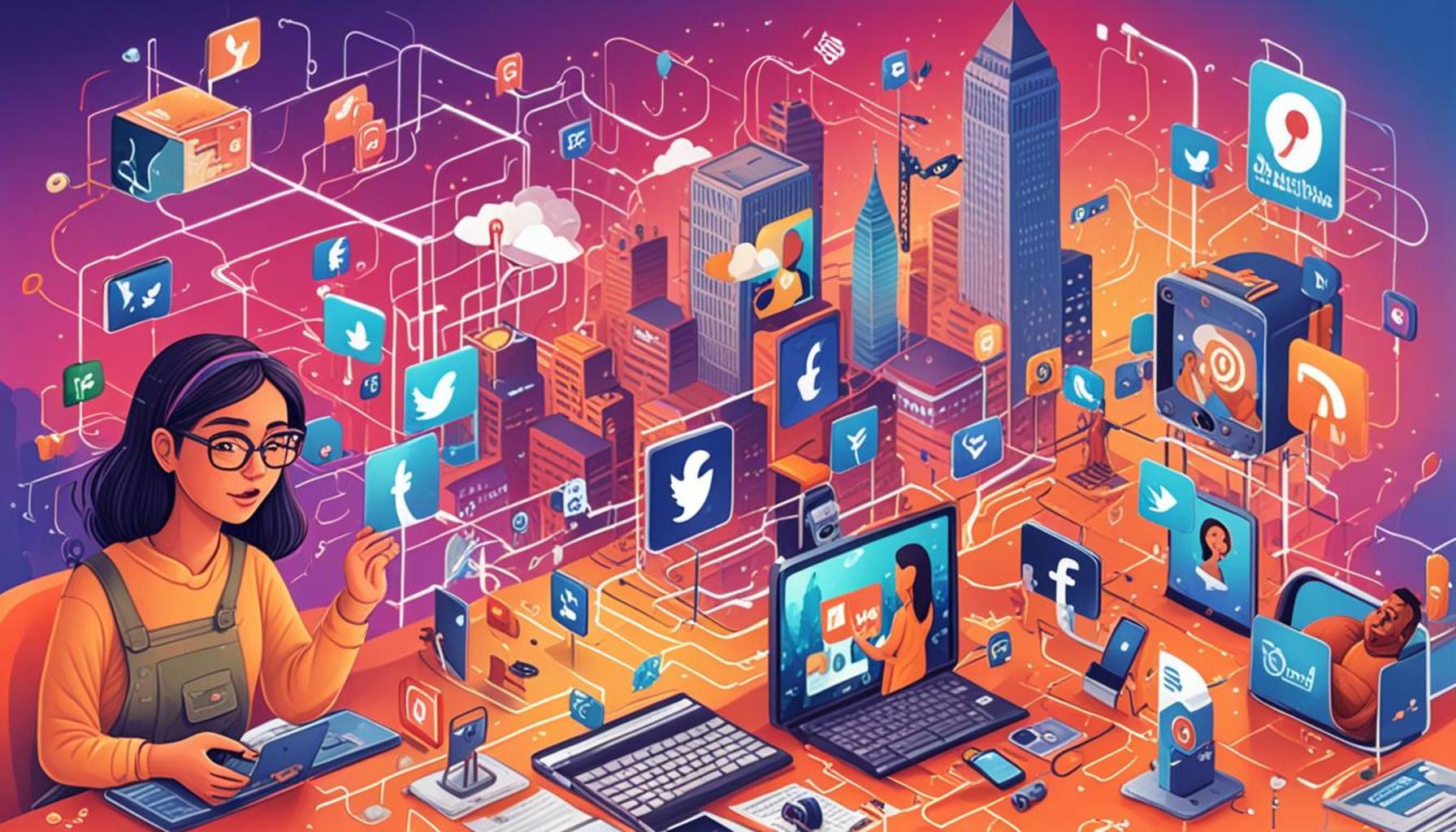How Social Media Can Increase Transparency and Accessibility of Government Assistance Programs

Navigating Government Assistance with Social Media
In an age characterized by the rapid exchange of information, social media has emerged not just as a platform for social interaction, but as a dynamic channel that can effectively bridge the chasm between government entities and the citizens they serve. For many, understanding government assistance programs can feel like traversing a labyrinth filled with dense jargon and complex eligibility requirements, leading to confusion and a prevalent lack of trust.
Fortunately, social media offers a range of innovative tools that enhance both transparency and accessibility in government communication. Let’s delve into some critical ways in which social media reshapes these interactions:
- Real-Time Updates: Government agencies are increasingly using platforms like Twitter and Facebook to disseminate instant notifications about program modifications or eligibility requirements. For example, during the COVID-19 pandemic, the Centers for Disease Control and Prevention (CDC) utilized social media to provide real-time updates about health assistance programs, ensuring that citizens were aware of changing circumstances.
- Direct Engagement: Social media fosters a direct line of communication between citizens and officials. Platforms such as Instagram and Facebook Live allow citizens to pose questions in real-time, and officials can respond promptly. This two-way communication nurtures a sense of community and builds trust in government processes. For instance, the U.S. Department of Education frequently holds Q&A sessions on Facebook to clarify student loan assistance programs.
- Awareness Campaigns: Social media’s visual and interactive nature serves as an effective medium for awareness campaigns. By utilizing engaging posts, infographics, and videos, government agencies can educate the public about available assistance. For example, the Supplemental Nutrition Assistance Program (SNAP) has created informative content on various social platforms to inform eligible families about their entitlements and how to apply.
Moreover, the analytics generated from social media interactions provide valuable insights that can help government agencies better understand community needs. By analyzing engagement patterns, agencies can tailor their outreach to specific demographics and regions. This data-driven approach not only improves service delivery but also encourages citizens to partake actively in government initiatives, promoting a culture of involvement and ownership.
As government assistance programs continue to evolve, particularly in the wake of technological advancements and societal changes, the influence of social media is poised to expand significantly. This shift highlights the necessity for citizens to stay informed and engaged. By unlocking the potential of these widely-used platforms, we can work toward a system where transparency becomes the norm and accessibility is a fundamental right ensured for all communities.
The intersection of social media and government assistance presents a unique opportunity to cultivate a more informed citizenry. It invites a wider discourse on how we, as a society, can harness the power of connectivity to not only navigate but also improve the systems that are designed to support us.
LEARN MORE: This related article may interest you
Empowering Citizens Through Social Media
As the digital landscape continues to evolve, social media platforms have become pivotal in not only disseminating information but also in creating a participatory environment for citizens engaging with government assistance programs. Social media allows for two-way communication, which enhances transparency significantly. By breaking down barriers that exist in traditional communication channels, citizens can now voice their concerns, seek clarifications, and provide feedback directly to the officials managing these programs.
One of the most compelling aspects of social media is its ability to foster a sense of immediacy. When government agencies utilize these platforms to share information, citizens receive timely alerts regarding any updates. In 2020, the California Employment Development Department (EDD) leveraged social media to communicate essential information about unemployment benefits amidst rising claims due to the pandemic. This proactive approach not only reassured the public but also minimized misinformation that often circulates during crises.
Moreover, accessibility is significantly improved through social media by providing information in multiple formats. Government programs can no longer rely solely on printed materials or static websites; instead, they can utilize a variety of engaging content formats, such as:
- Short Videos: Quick, informative videos can break down complex processes into digestible content, making it easier for individuals to understand how to apply for various programs.
- Live Streams: Agencies can host live Q&A sessions, allowing citizens to ask questions about programs and receive immediate clarification from knowledgeable officials.
- Infographics and Visual Content: Visual aids are particularly effective in simplifying data-heavy information, making it more accessible to a broader audience, including those who may struggle with text-heavy communication.
This transition to more engaging formats not only enhances understanding but also attracts a younger audience more accustomed to seeking information through visual storytelling. For instance, platforms like TikTok are now being explored by certain government agencies, reflecting an innovative approach to reach younger demographics who may benefit from assistance but are unaware of their eligibility.
Data analytics derived from social media interactions also offer valuable insights into community needs and concerns. By monitoring engagement metrics, government agencies can identify which programs are most sought after and where additional outreach is necessary. For example, a spike in inquiries about food assistance programs may prompt a rapid response to ensure heightened visibility and access to resources like the Supplemental Nutrition Assistance Program (SNAP). These analytics not only promote efficient resource allocation but also enable governments to tailor messaging to resonate with specific communities across diverse regions.
Ultimately, by embracing the capabilities of social media, government assistance programs can achieve a transformative shift towards transparency and accessibility. This evolution not only empowers citizens but also builds trust between government entities and the communities they serve. As we navigate the rapidly changing landscape of social media, it is essential that both stakeholders and citizens remain proactive participants in this ongoing dialogue, ensuring that the systems designed to help them are not only accessible but also reflective of their needs.
| Category | Key Features |
|---|---|
| Increased Public Awareness | Social media platforms serve as vital channels for broadcasting information about government assistance programs. This helps citizens stay informed about available support. |
| Real-Time Communication | Platforms allow for direct interaction between the public and governmental agencies, fostering transparency and swift dissemination of information regarding program updates and eligibility criteria. |
| Feedback Mechanism | Social media provides a platform for feedback from users, which can enhance the accessibility of government programs by addressing concerns in real time. |
| Community Engagement | Through sharing stories and experiences, users can engage with each other, creating a community that promotes understanding and support for government assistance initiatives. |
The role of social media in elevating the transparency and accessibility of government assistance programs cannot be overstated. Through a variety of innovative features that define these platforms, officials can clarify complex processes and demystify the steps required to access vital services. Furthermore, the instantaneous nature of social media creates an environment where queries about assistance programs can be addressed immediately, allowing citizens to feel more supported in their pursuit of aid.Not only do these channels enable public discourse, but they also empower individuals to contribute their experiences, leading to a more transparent understanding of how effectively assistance programs are functioning. The community engagement fostered by social media ultimately reveals the importance of feedback in refining these initiatives, ensuring they are not only accessible but also relevant to the needs of the population. The integration of social platforms with traditional outreach methods promises a future where government assistance is not only well-known but widely embraced.
CHECK OUT: Click here to explore more
Building Trust Through Transparency
The role of social media in enhancing transparency is increasingly critical as citizens demand accountability from their governments. Government assistance programs that actively engage with citizens on social media can foster greater trust by showing openness in their operations. When agencies share not only successes but also challenges and setbacks, it cultivates an environment of honesty and integrity. For instance, agencies can openly discuss the limitations of funding or acknowledgment of mistakes in the application process.
Another remarkable benefit of social media is its capacity for real-time updates. This immediacy can prove vital during emergencies when government assistance programs are front and center. During natural disasters, for instance, governments can quickly communicate with citizens about available relief programs, deadlines for applications, and eligibility criteria. Take Hurricane Harvey in 2017; local officials utilized various social media channels to inform residents on how to access FEMA assistance swiftly. By doing so, they not only dispelled rumors but also fortuitously guided communities through turbulent times.
Social media also serves as an inclusive platform for providing multilingual resources, which is increasingly essential in the United States, a nation with diverse populations. Government agencies can use platforms like Facebook and Twitter to disseminate information in multiple languages, thereby ensuring that limited English proficiency (LEP) individuals are not left behind. This is particularly significant for programs such as Medicaid and CHIP, which provide critical health coverage to underrepresented communities. By catering to linguistic needs, agencies can expand their reach and encourage broader participation.
Furthermore, ease of sharing on social media amplifies the reach of government information. Citizens can share posts about government assistance programs with their networks, effectively becoming informal ambassadors for those initiatives. This grassroots approach can enhance visibility and awareness, especially among demographics that traditional outreach methods may overlook. For example, peer-to-peer sharing on platforms like Instagram or WhatsApp can lead to viral campaigns, whereby information about valuable services reaches individuals who may otherwise remain uninformed.
Another innovative application of social media is the crowd-sourcing of information. Governments can create feedback loops, encouraging citizens to share their experiences with various assistance programs. This data can reveal common pain points and unique hurdles individuals face when navigating these systems. Agencies may then implement changes based on concrete feedback, ensuring that assistance programs remain effective and user-centered. A notable case is the U.S. Department of Agriculture’s Social Media Platforms that invite Americans to engage in conversations around food assistance programs like SNAP, significantly contributing to program improvements.
This dynamic engagement on social media can also catalyze partnerships between government agencies and community organizations. By collaborating with local nonprofits that understand the cultural nuances of the populations they serve, agencies can weave a social media narrative that not only informs but also connects. These partnerships enable the development of tailored messaging that resonates with the communities they aim to assist. As seen with initiatives like the “#FoodIsLove” campaign, these partnerships have the potential to address food insecurity with culturally relevant approaches that garner deeper community engagement.
In the ever-evolving landscape of communication, social media stands out as a transformative tool that can reshape the way governmental assistance programs engage with the public. By fostering an inclusive atmosphere through transparency, accountability, and real-time connectivity, these programs can not only broaden their reach but significantly enhance their efficacy among citizens nationwide.
CHECK OUT: Click here to explore more
Enhancing Government Engagement in the Digital Age
In conclusion, the ability of social media to reshape the relationship between government assistance programs and the citizens they serve cannot be overstated. As public demand for transparency and accessibility grows, social media serves as an essential conduit for fostering community engagement, sharing vital information, and gathering feedback. By leveraging platforms such as Facebook, Twitter, and Instagram, government agencies can reach broader audiences, ensure that information is available in multiple languages, and quickly disseminate updates on critical assistance programs during times of need.
Moreover, this transparent communication nurtures a culture of trust, as citizens witness agencies engaging in genuine dialogue about both the successes and limitations of their services. As demonstrated by initiatives during emergencies like Hurricane Harvey, timely updates on social media can facilitate access to much-needed support. The crowd-sourcing of citizen experiences enhances the user-friendliness of these programs, paving the way for necessary improvements tailored to the needs of diverse populations.
With the power of social media, partnerships with local organizations can flourish, leading to culturally relevant programming that resonates within communities. As the digital landscape continues to evolve, the potential for social media to advance the transparency and accessibility of government assistance programs remains a compelling frontier. Policymakers and public servants must recognize and embrace this tool, as it not only enables them to serve the public better but also empowers citizens to play an active role in their governance. In doing so, we can envision a future where government services are more inclusive, informed, and impactful than ever before.


